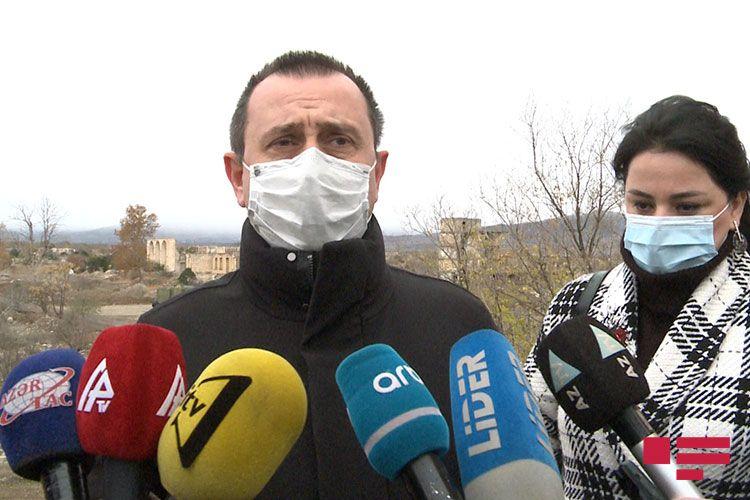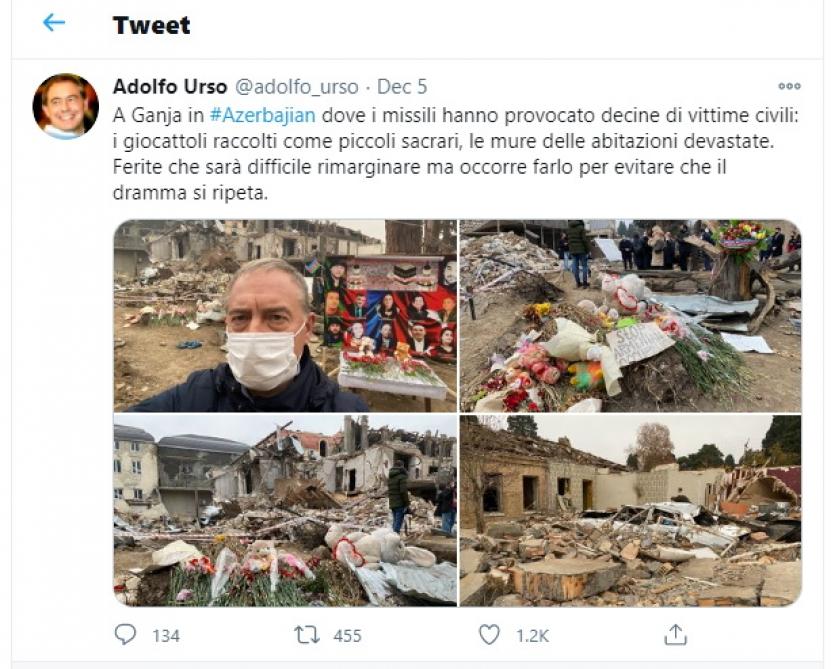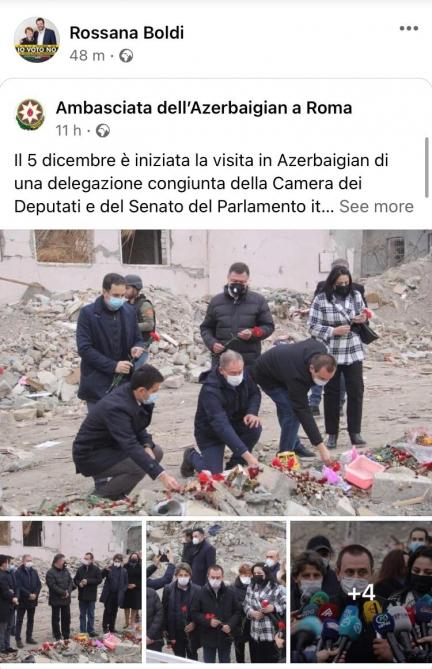Italian MPs inspect scenes of Armenian-inflicted violence in Aghdam region, Ganja city

By Vafa Ismayilova
Senior Italian MPs have visited newly-liberated Aghdam region of Azerbaijan, which had remained under Armenian occupation for 27 years, and Ganja city, where dozens of civilians were killed in Armenian missile attacks.
Deputy Speaker of the Italian Chamber of Deputies Ettore Rosato visited the liberated city of Aghdam along with Azerbaijani ambassador Mammad Ahmadzada, head of the Azerbaijani-Italian inter-parliamentary relations group Azar Karimli and other Azerbaijani MPs.
“We have witnessed violence in Aghdam, all houses, all infrastructure have been destroyed, nature has been damaged. As a result of the great efforts of the Azerbaijani people, life will return to these lands, destroyed houses will be rebuilt. I believe that when we come here in 5 years, we will face a different picture," Rosato told journalists.
The purpose of the visit was to review the consequences of the war crimes committed by the Armenian armed forces.
Italian MP Allessandro Alfieri described in Facebook account in detail the scenes he had witnessed in Ganja and Aghdam. He noted that all the vineyards on the road to Agdam, once a prosperous city in Azerbaijan, were destroyed, the fields were turned into a desert, the surrounding areas were mined and only special military units were clearing the area. He added that although the war ended, the civilians still have to wait to return to those territories. The MP underlined the tragedy of a family whose members were killed in a mine blast a few days ago while trying to visit their relatives' graves.
Another visiting Italian MP Cianluca Ferrara said that the road to Aghdam, which is described as Hiroshimo of the Caucasus, passed through the mined areas. He noted that Aghdam, which turned into the "city of ghosts" was occupied and destroyed by the Armenian troops in 1993 and the only safe building was a mosque in the city. He also stressed that the mosque was used as a pigsty during the years of occupation. As a member of the first international mission who managed to closely witness this horror and unprecedented vandalism, he expressed confidence that Azerbaijanis will soon return to those deserted areas.
In his notes, member of the Italian Senate Adolfo Urso spoke about the missile strikes on Ganja that killed dozens of women, children and the elderly. He presented the destroyed families, toys of killed children and destroyed walls of houses as manifestations of a wound that is difficult to heal. He noted that those wounds and pains needed to be healed to prevent those dramatic events from being repeated. Urso described the use of the Aghdam mosque as a pigsty as an insult and regretted that all what he witnessed was the "painful truth".
The MPs shared their views in Italian on their Facebook, Twitter and Instagram accounts, Azertag reported.
On December 6, the members of the abovementioned delegation visited the area in Ganja, in which buildings were damaged and a big number of civilians were killed and injured on October 11 and October 17, as a result of the missile attacks of the Armenian armed forces. First, flowers were laid at the destroyed residential building to revere the memory of the victims.
The purpose of the visit was to familiarize the Italian parliamentarians with the consequences of the crimes committed by Armenia against civilians in Ganja, the second biggest city in Azerbaijan located far from the front line.
Ten people, including five women, were killed as a result of a war crime committed by the Armenian troops in Ganja on October 11. Some 34 people, including 10 women and 9 children, were injured. Another similar war crime was committed by the Armenian armed forces on October 17.
As a result of the missile attack in the central part of Ganja, 16 people, including 6 children, were killed. More than 55 people were injured. Numerous civilian infrastructure facilities and vehicles were greatly damaged. The strikes by using Tochka-U, Smerch, Scud and other missiles on densely populated areas, in which civilians live, at night were aimed at destroying a big number of civilians.
Despite the deliberate attack on civilians is a crime against humanity, Armenia continued to commit war crimes in violation of the norms and principles of international law, including the 1949 Geneva Conventions and their Additional Protocols, as well as the requirements of the humanitarian ceasefire.
The 44 days of war in and around Nagorno-Karabakh ended with the Russian-brokered peace deal signed on November 10 by the Azerbaijani, Russian and Armenian leaders. Under the peace agreement Azerbaijan’s Kalbajar, Aghdam and Lachin regions were vacated by the Armenians by December 1. The agreement also envisages the return of Azerbaijani IDPs to Azerbaijan’s Nagorno-Karabakh and the seven adjacent regions under the control of the United Nations High Commissioner for Refugees.
The clashes between Armenia and Azerbaijan resumed after Armenia launched large-scale attacks on Azerbaijani forces and civilians on September 27. Five Azerbaijani civilians were killed in the first day of the Armenian attacks. Over 90 Azerbaijani civilians were killed in Armenian's indiscriminate attacks on Azerbaijani civilians. Azerbaijan launched counter-offensive operations that ended in the liberation of over 300 settlements, villages. Azerbaijan also liberated five city centres and the historic Shusha city that was liberated on November 8.
The peace agreement ended the 30-year-old conflict between Baku and Yerevan over Azerbaijan’s Nagorno-Karabakh region that along with the seven adjacent districts came under the occupation of Armenian armed forces in the war in the early 1990s. For about three decades, Armenia failed to implement the UN Security Council resolutions demanding the withdrawal of the Armenian troops, which was the main obstacle to the resolution of the conflict.
--
Follow us on Twitter @AzerNewsAz
Here we are to serve you with news right now. It does not cost much, but worth your attention.
Choose to support open, independent, quality journalism and subscribe on a monthly basis.
By subscribing to our online newspaper, you can have full digital access to all news, analysis, and much more.
You can also follow AzerNEWS on Twitter @AzerNewsAz or Facebook @AzerNewsNewspaper
Thank you!


